
Head Surgery Page Menu: 1 2 3 4 5 6 7 8 9 10 11 12 13 14 Next>>
Head Surgery During the Golden Age of Piracy, Page 5
Pre-Op: Dilating or Opening the Wound
"But now if there be a large Wound, yet that doth not prevent your Incision; for when you have shaved the Head, you must dilate the Wound of the Cutis Muscula [Latin, literally 'skin muscle'], that it may be much larger than the Fracture, that you may the better handle the Fracture" (John Moyle, The Sea Chirurgeon, 1693, p. 107)
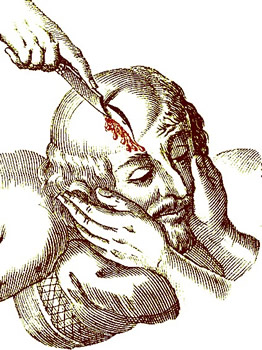
Artist: Jonas Arnold Delineavi
Using a Razor To Slice Open the Scalp, From
Armamentarium Chirurgicum Bipartitum,
by Johannes
Scultetus (1666)
Samuel Johnson tells us in his dictionary that to dilate is "To extend; to spread out" and "To widen; to grow wide."1 When surgeons use the term 'dilate', they are referring to cutting an existing wound open further to allow better access to it. This is made fairly clear by Johannes Scultetus when discussing the case of a quartermaster with a head wound. "I dilate the wound in the temporal Muscle with with an Incision knife"2.
John Moyle recommends incising the scalp "that you may either see or feel the whole Fracture. And see that you remove the Pericranium likewise, all that breadth; that the bone may be bare."3
Richard Wiseman was more direct in his comments on choosing to open the scalp to find a fracture.
If you doubt of a Fracture there [in the skull], you may boldly cut into the Hairy scalp [to try to find it]: it [the scalp] is of an obtuse sense, and easily healed up again. But be cautious how you make your Incision in the Forehead, where a traverse Wound may cause the Eyebrows to fall over the Eyes. Therefore if you are forced to make Incision, let it be according to the length of the Fibres. And be careful that you make no Incision upon the Temporal Muscles, for thereby Convulsion and other Accidents may happen.4
Wiseman is not alone in this belief; Paré explains that "it is far better to bare the bone by cutting the skin, then to suffer the kind & nature of the fracture to remain unknown, by a too religious preservation of the skin; for the skin is cured without any greate ado though pluckt off to no purpose."5
Wiseman explains some of his process of checking for a fracture in one of his case studies. First he had the head shaved, then he "made a circular Incision about the Wound. Then raising up the Hairy scalp smooth off with my Spatula, I both saw and felt the Bone, but could discover no fault in it. I dried up the blood with Spunges dipt in Vinegar, raised up the Lips round with my Spatula from the Bone, and with a fresh Spunge having dried up the blood, I looked again under them; but could discover nothing ill in the bared Cranium."6
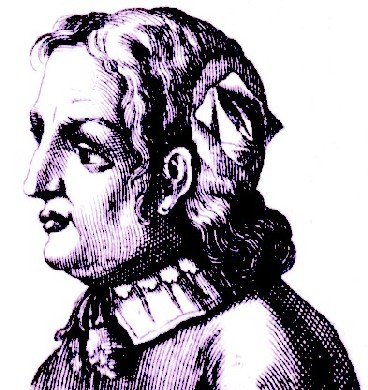
Armamentarium Chirurgicum Bipartitum, Johannes
Scultetus (1666)
Although he didn't find the fracture, Wiseman's use of a spatula is an interesting way to remove the scalp from the skull.
It is interesting that Wiseman uses a circular cut around the wound in the above case study. He elsewhere says that where the patient's symptoms suggest there is a fracture "you are then without delay to open the Hairy scalp according as the Part will admit, angularly, or in the manner of a Cross, or of the Letter T, then the Fracture may be discovered by the raising of it up with its Pericranium. For if you shall in doubtful Fissure or Fractures make a round Incision, and take out the whole pieces [of skin]; then, if there chance to be no Fissure, you have made your self a long work [in healing the wound] to little purpose"7.
Wiseman continues his warning against round incisions, explaining that
if the Fissure run under the Hairy scalp farther than you made your Incision, you may then be necessitated to cut it open that length: by which it will appear you have through mistake laid it open more than was necessary in one place, and too little in another, doing that which neither Hippocrates nor any judicious Chirurgion [surgeon] would ever allow. Whereas if you had laid it open by a cross Incision, you might by only raising the Scalp have discovered the Fissure or Fracture: and if yet part of the Fissure or Fracture had lain undiscovered, you might have stretcht your Incision to it: and in case after all there had been no Fracture nor Fissure, which often happens, especially in Contrafissures [fissures on the opposite side of the head from a wound], then you might have laid the Hairy scalp down again, and easily cured it; which by an excision [removal] of part of the Scalp you cannot do.8

Artist: Jonas Arnold Delineavi
Triangular Skull Incision, From
Armamentarium Chirurgicum
Bipartitum,
by Johannes
Scultetus (1666)
Paré advised the surgeon to make the incision through the scalp "in a triangular or quadrangular figure to a proportionable bigness, alwayes shunning as much as in him lyes, the sutures and temples"9.
Moyle similarly suggests that the surgeon "divide the Cutis [skin] and Carnous Muscle cross wayes to the bone, a convenient breadth; open it under the cross Incisions, separating it from the bone, and cut off the angles of the incision, and then the Wound will be round, but be sure it be wide enough"10.
Sea surgeon John Woodall likewise advises his reader "your incision is either to be made directly crosse, or in the forme of this Romane T: and when the cutis is divided, together with membrane carnosa, or fleshly membrane, the Pericraniu[m] or Panicle covering the scull is also to be take[n] away, that the fractured part be bare"11.
For performing the cutting, several of the authors suggest using an incision knife to cut the scalp12, while Paré offers the option to employ a razor for that purpose.
Once the skull was revealed, the surgeon would search for the fracture. Paré gives a very vivid description of how this was performed.
...if the fracture be not too obvious to the eye, you must try [to find it] with your probe, which must neither be too thin nor too sharp, lest by falling into some naturall cranies, it may cause us to suspect without any cause that the bone is broken; neither let it be too thick, lest the little clifts may deceive you. If when your probe comes to the bone, it meets with nothing but that which is smooth and slippery, it is a sign that it is whole.
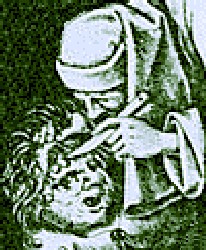
Artist: Peter Bruegel the Younger
Probing the Head (1559)
But on the contrary, if you find any thing rough, specially where there is no suture, it shows the bone is broken.13
In one of his case studies Moyle suggests a different method for searching, explaining that he could feel "the Bone fould [foul] and salebrous [rough] with my Finger, (for I darest not trust to a Probe) "14. Although the difference between searching with a finger versus a probe isn't discussed in detail, it is possible that the more familiar the surgeon was was with the operation, the more likely he would be able to tell the difference between a "smooth and slippery" surface versus a rough one using a probe. Or it may have just been due to the surgeon's personal preference.
Sometimes the search for a fracture had to be delayed due to bleeding. In a case study Moyle notes that after the skin was opened, "the Depression [in the skull] was seen plain, which before was but imperfectly felt with the Hand, (for the Contusion being much, did impede;)... [although] the Fissure was not seen as yet, by reason of the Bleeding from the Incisure."15 Because of this, Moyle dressed the skull. (The procedure for dressing the wound is discussed in the next section.)
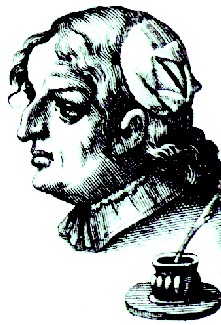
Ink Reveals the Fracture , From
Armamentarium
Chirurgicum
Bipartitum,
By
Johannes
Scultetus (1666)
Moyle was not alone in suggesting this; Ambroise Paré explained that when "it come so to pass that the blood flows forth so violently [from a wound] that it can be stayed by no means, the vessel itself must be bound"16.
When the fracture can't "be perceived with your fingers and probe" but the patient's symptoms suggest that there is a skull fracture, Paré suggests using Ink to find it.
Then you must anoint ...the bared bone with writing Ink, and a little oyl of Roses; that the cleft or crack may be dyed or coloured therewith, if that there be any there. Then the next dressing you must dry the bone with a linnen cloth, and scrape off the Ink, and oyl, with scraping Instruments made for the purpose, if any part thereof shall be sunk into the bone; for if there be any crack, it will be black.17
Although he doesn't discuss ink in his general procedure, Moyle mentions its use in one of his case studies. After he was unable to detect the fracture using his finger, he proceeded "by rubbing Ink on the Bone, and then scalping [scraping] of it, [the ink] manifested all the rest of the Fissure"18.
1 Samuel Johnson, "To Dilate", A Dictionary of the English Language, 3rd ed., 1768, not paginated; 2 Johannes Scultetus, The Chyrurgeons storehouse, 1674, p. 227; 3 John Moyle, The Sea Chirurgeon, 1693, p. 108; 4 Richard Wiseman, Several Chiurgical Treatises, 2nd ed, 1686, p. 374; 5 Paré, p. 265; 6 Wiseman, p. 393; 7 Wiseman, p. 379; 8 Wiseman, p. 379-80; 9 Paré, p. 265; 10 Moyle, p. 107-8; 11 John Woodall, the surgions mate, 1617, p. 5; 12 See for example Paré, p. 265 & Moyle, Sea Chirurgeon, p. 108; 13 Paré, p. 265; 14 John Moyle, Memoirs: Of many Extraordinary Cures, 1708, p. 24;15, Moyle, Memoirs, p. 12; 16,17 Paré, p. 266; 18 John Moyle, Memoirs: Of many Extraordinary Cures, 1708, p. 13
Pre-Op: Wound Treatment
When a wound or an incision made to bare the skull would not stop bleeding, the surgeon was sometimes forced to dress that wound so that it could heal enough to cease bleeding. This allowed the surgeon to search for fractures or perform other operations on the skull. Several surgeons mention ways to dress the wound for this purpose.
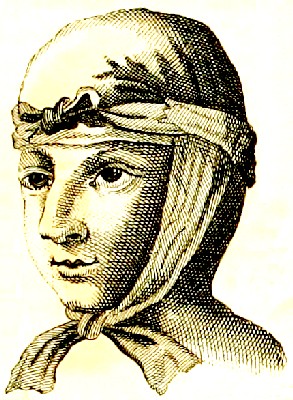
Head Bandage, From A General System of Surgery,
By Lorenz Heister (1750)
In one case study, sea surgeon John Moyle used pieces of lint embedded with a mixture of powdered barberries ('Pulverised Galeni'), powdered rabbit's teeth and egg white, further moistening everything with a embrocating (softening) medicine and covering the head with a barley-based poultice. He then bandaged the head. The next morning "the Bone was dry, and no Blood to trouble us, and the lower end of the Fissure appeared"1.
In another case Moyle used powdered barberries with cloth soaked in wine vinegar for the same purpose, again looking for a fracture on the following day.2
In one of his case studies, French surgeon Ambroise Paré placed "lint rolled up to the bigness of a Goose quill" under the skin of a profusely bleeding wound. He sutured the scalp over the bandages which placed pressure on the wound and allowed it to stop bleeding. He explains that the surgeon could then return the next day to "consider with what kind of fracture the bone is hurt"3.
Sea surgeon John Woodall advised his surgeons:
have ready your medicines to binde up the wound againe, as namely your spunge, your ligature with hot water, and each other thing necessary for a dressing it... and if so be that the fluxe [flow of blood in the wound] hinder not, [use] wine and hony to foment the greeved part after the incision be made. It will doe well if it be in the ship to make also a restrictive [medicine to stop bleeding] ready, namely of Bole [Armeniac] with water and vinegar, if an egge be not to be had; but an egge in the restrictive will make it the better. And further if that the fluxe will not be stayed by an ordinary kinde of restrictive, then take the stronger restrictive powder which in due place is to be mentioned. And for present applications into the wound you have good choice of two sorts, namely Oyle of Roses, and Mel Rosarum mixed warme, or the Linamentum Arcei4
Woodall's recommendations seem to make sense because they include several of the recognized restrictive medicines for stopping bleeding such as clay, eggs and powders. Moyle's medicated rags also seem logical, although the softening medicine and drawing poultice are unusual choices. Of the three suggestions, however, Paré's simple application of small rolls of cloth with pressure on them by the stitched skin might be more effective than the medicines if the wound was not re-opened when the stitches were removed the next day.
1 Moyle, Memoirs: Of many Extraordinary Cures, 1708, p. 13; 2 Moyle, Memoirs, p. 19-20; 3 Ambroise Paré, The Workes of that Famous Chirurgion Ambrose Parey, 1649, p.266; 4 John Woodall, the surgions mate, 1617, p. 4-5

